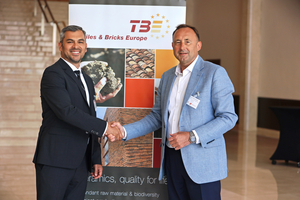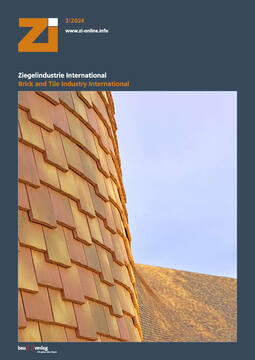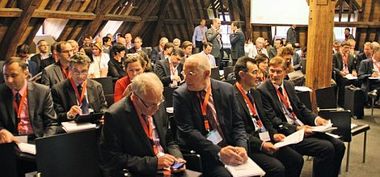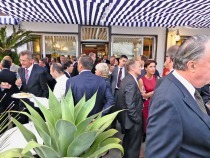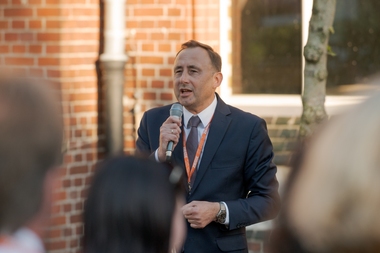„Believing in the European Spirit“
At the end of October last year, ZI editor Victor Kapr met with the new presidents of the European association Tiles and Bricks Europe (TBE) elected in June 2023 at the Bellenberg Wiest brickworks in Bavaria. In conversation with the plant‘s Managing Director and President Murray Rattana-Ngam and Vice President Miroslaw Jaroszewicz, the aim was to understand the importance of European politics for the brick and tile industry. After all, European policy is not very visible in the day-to-day running of the plant. However, its consequences are all the more significant and determine the future of the industry. The following interview is based on this conversation and later additions.
TBE and its presidents
Mr Rattana-Ngam, Mr Jaroszewicz, what goals have you both set for your presidency and vice-presidency respectively?
Murray Rattana-Ngam (MRN): On a fundamental level, the goals for this term will not differ from those in the past. We represent the interests of the brick and tile industry at the European level. While specific topics might change, the interests mostly remain constant.
Miroslaw Jaroszewicz (MJ): Our responsibility is to raise the voice of our industry on the European level and to be heard by those who establish the playing field for the industry. This is the only way to politically ensure that the industry retains the potential and adequate opportunities for future development.
Since the founding of the EU’s predecessor, the European Coal and Steel Community, business legislation has been trans-national. Advocating the industry’s interests therefore requires building and maintaining the dialogue with the European institutions, transgressing purely national perspectives. For this reason, TBE was founded 71 years ago.
This dialogue entails two parts. On the one hand, we need to know what the union’s priorities and the expectations for the industry on the European level are. On the other hand, we can and have to explain how the industry can technically implement these expectations and what the economic and social consequences are.
You have both been active in TBE for a long time. You, Mr. Jaroszewicz, were TBE vice president from 2015 to 2017, then president until 2023, and are now once again vice president. Mr. Rattana-Ngam, you have served as vice president since 2020 and since last year as president. What drives you to dedicate part of your time in TBE?
MJ: I do it because people matter to me. I value and appreciate the human relations that are part of working for TBE: Meeting and working with people, learning from them, giving and receiving support. Also, working for TBE impacts those economically dependent on the brick and tile industry and those profiting from bricks as a beautiful and sustainable building material for good and healthy living.
MRN: Three reasons motivate my decision. First, before entering the brick industry, I worked as an international entrepreneur, spending a lot of time abroad. Living in different countries and cultures, exchanging views and learning reasons for certain ways, was a fascinating experience.
Secondly, decisions affecting our work at Bellenberg brick plant are made somewhere else. If these lead in the wrong direction, in my opinion you should try to intervene, explaining the demerit and offering a better. If possible, I prefer to change something instead of just complaining.
Thirdly, Matthias Frederichs, former managing director of the German Brick and Tile Industry Association, had the idea of me joining TBE’s efforts. He convinced me that my special, practical perspective on the industry as managing director of a brick plant would be very valuable for TBE.
Of course, investing any time into TBE is possible only because I only manage one plant with a great and professional team, allowing me to be occasionally absent.
The same holds true for TBE work itself. The president can only be successful because of the team’s work. We are lucky that we have a dedicated and professional team that excels in detail work. The outstanding work of all my colleagues is my greatest motivation and makes me very proud to be a part of it.
MJ: To be able to work in this constellation and to lead a big organization like TBE would not be possible without a competent and dedicated team manning our office. Moreover, we receive constant support from our mother organisation Ceramie-Unie, the working groups and the experts and organisations from different countries.
MRN: This also shows that we all, from different countries and companies, work together very well. Despite problems, this is the European spirit we all believe in.
TBE and technical matters
Which topics currently on the agenda at European level are most relevant to the brick and tile industry and why are they relevant?
MRN: Many of the issues most relevant for the brick and tile industry at EU level have a direct impact on the competitiveness of our industry, for example on the energy and carbon costs paid by each producer.
The EU has an ambitious policy pursuing climate targets and decarbonisation of industry. For example, the carbon price has more than tripled since the beginning of 2021. Over 600 brick and roof tile installations in the EU have to comply with it by purchasing CO2 permits. Another example is the EU Emission Trading Scheme (ETS). When it was reviewed for the years 2026 to 2030, we participated actively in this process advocating for our industry. In the next years, we will also face a discussion on the Carbon Border Adjustment Mechanism (CBAM). Just established by the EU, it stipulates importers to pay the carbon price and help avoid carbon leakage. Currently the ceramics industry is not included in the scope of CBAM. However, the Commission’s plans to extend it in the future might also include ceramics.
Colleagues from CerameUnie, TBE, high-ranking representatives from the countries and I, together with Mr Thomas Gerassimos, Director General of the Taxation and Customs Union Directorate-General (DG Taxud), and his team, presented our study on CBAM just a few weeks ago. With this independent study, we were able to explain and discuss the consequences of CBAM for the brick and roof tile industry. According to the information currently available to us, only the brick industry in Europe would face additional costs (in addition to ETS trading) totalling 2.2 billion euros between 2026 and 2035. In our view, further cost increases are jeopardising the ceramic industry in Europe. The consequence could be that in future ceramic products could only be produced outside the EU countries and ceramic expertise in Europe would permanently disappear.
MJ: At the same time, TBE has been actively working on the pathways to decarbonize the brick and tile industry. We have contributed to the creation of the Ceramic Roadmap to 2050, which aims at net zero emissions by 2050. This requires many conditions to be fulfilled, like accessibility of affordable decarbonized energy sources. Consequently, we follow these developments and issue relevant policy recommendations.
What does TBE want to achieve in these areas?
MJ: Our main aim is to promote our industry at the EU level and to ensure that the European legislation does not undermine the competitiveness of the brick and tile sector. This comprises protesting against unnecessary administrative burden on the industry or any undue production costs.
This is also the reason why we aim at a legislation that is neutral regarding technology and material. There is always the possibility of legislators fixing on a singular approach as a seemingly simple solution to climate neutrality, for example with biobased building material like wood. That is why we together with a few other building materials sectors commissioned a study accounting carbon for building materials, critically assessing the merits of this claim.
TBE and industry
Can you give an example of TBE work and its practical impact on the day-to-day business of brick and tile producers?
MJ: One example is the Carbon Leakage List for the free allocation of emission rights/certificates. This is an important factor for the cost structure in production. Being on the list makes you eligible for receiving some free certificates. The number of certificates is reduced yearly. We as TBE participated in the dialogue about the speed of this reduction process, highlighting the need of our industry for a longer perspective and reaching a compromise with the European Commission. Thanks to the qualitative assessment on carbon leakage submitted by the TBE to the Commission in 2018, all EU brick and tile installations continue to receive free allowances. This example shows that hard work and open dialogue can have a positive effect. We are always interested in open dialogue and a fair assessment and classification of our industry.
Another short-term example concerns a list created by the European Commission of energy intensive sectors which are eligible for public help and subsidies in the face of the huge increase in energy prices when the war in Ukraine started. If a sector is not listed, EU regulations stipulate that it cannot receive national subsidies. At first, our industry was not included in this list. Due to TBE’s advocacy, the ceramic industry was added in the last quarter of 2022. I know that since then in some countries financial support was granted to our industry.
Consider now the perspective of individual, local producers. They would not even know that this list is being worked on. That is why it is so important to have a representative to monitor European legislation. That is why we need an office and a competent team in Brussels.
MRN: There are many other examples of practical implication for producers in their daily business.
The Construction Products Regulation (CPR) is a set of harmonised rules for the marketing of construction products in the EU. TBE was actively involved in its development. The Regulation provides a common technical language to assess the performance of construction products. It ensures that reliable information is available to everybody to compare the performance of products from different manufacturers in different countries. The producers work with it every day, for example the CE marking.
Another area of work is the environmental legislation, where the ceramic BREF (Best Available Techniques Reference Document) is being reviewed. The TBE members work actively with the European Commission and the Member States’ experts to establish realistic and fair pollutants emissions level values for the plants in the EU. After revision, they will have an impact on each industrial permit.
What is the importance of TBE for the national brick and tile industries? Is this also reflected in the commitment of national associations and industry participants?
MRN: That depends on the country. In Germany in the past, brick producers focussed more on the building site in the neighbouring village than following news from Brussels, not understanding the latter’s importance. There was hardly any participation in work groups or communication.
This changed with Matthias Frederichs, who raised awareness and began to communicate EU issues and problems. With our current Managing Director of the Federal Association of the German Brick and Tile Industry, Mr Attila Gerhäuser, this course is being continued professionally. Mr Gerhäuser has already been active in Brussels for over 8 years and, with his network, provides significant support to brickworks in Germany and the EU.
The EU’s CPR helped changing the brick producers’ attitude, too. It immediately affected the requirements for the products they offered, thereby making the EU’s relevancy for their own business tangible.
In other countries, brick producers have paid more attention to the EU. This holds especially true for those countries where Wienerberger is invested. As an international company, they have a different access to information and, of course, an interest in supranational legislation.
MJ: We try to involve as many different perspectives as possible in the working groups, from different countries and companies. Legislation on the EU level tends necessarily towards homogenous solutions. However, as the needs and capabilities of the companies and countries are heterogeneous, conveying these different perspectives into the legislative debate is very important. Therefore, the support TBE receives from the individual countries and companies does vary, according to the issue at stake.
TBE is therefor also a platform for our experts from the companies and national associations to exchange and cooperate. Together with Cerame-Unie, our umbrella association, we hold regular meetings, conferences, webinars, European Ceramic Days and Annual TBE Congresses.
The TBE experts are currently involved in six active Product Groups and Working Groups: Masonry PG, Roofing tiles PG, Sustainable Construction WG, Sustainable Finance WG, Regulated Dangerous Substances Ad-hoc Group, and Circular Economy Task Force.
TBE and the future
What is the organisational and topical perspective of TBE?
MJ: Decarbonization and securing the future development of our industry will remain the central topics of the next years. We will also need to accelerate our efforts. The “Fit for 55” programme’s target date is 2030, by which we need to emit 55 percent less CO2 than in 1990, which is only six years away. According to a report by the European Commission, in 2022 we had reduced emissions by only 32 percent. That leaves us with 23 percent to go in only a couple of years. However, we need to focus on balancing the reduction efforts between the sectors, too. Industry and construction sectors were largely responsible for emission reductions until now. Lifestyle did lag behind and transportation emissions actually waxed. Those sectors need to increase their efforts.
MRN: However, we are dependent on the rapid expansion of the necessary infrastructure. It is important to understand that the brick and roof tile industry and the entire European industry can only achieve the desired goals if the energy infrastructure is expanded at the same pace. We see a considerable delay in both the expansion of the grid for electrical energy and the possible expansion of the hydrogen grid. The entire industry in Europe is dependent on this expansion of the grid infrastructure and energy prices must still allow for competitiveness. Both are not subject to the influence of companies. It is therefore extremely important that the EU and national institutions make rapid progress in this area.
Does the brick industry have a future in Europe? Does the brick have a future in Europe as a mass building material?
MRN: History shows, the industry has survived quite a lot. The history of bricks is thousands of years old and continuing today. I am quite optimistic that both will play a role in the future. A greater appreciation of bricks might be the key. It is not just a mass building material, but one of the best materials for people’s homes, durable and reusable for generations. Homes from bricks retain their value.
MJ: European history is a ceramic history. Currently, we are on a pathway of change and we need time for the transition. The brick industry is adapt at successfully transforming itself. Today’s products are totally different from the past‘s. Then, one brick was used universally. Now, there are specialised solutions for specialised applications. We will continue in this direction, striving for a different solution.
Looking only three decades back, we see development is accelerating. Bricks, blocks, and tiles did not change or develop in the whole 19th century as much as in the last five years. Moreover, we adapt our products to the customer’s specific needs. We are interactive partners, listening to our partner’s needs and capable of meeting their expectations.

